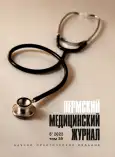Evaluation of treatment efficiency of diabetic foot syndrome using immunohistochemical studies
- Authors: Styazhkina S.N.1, Bayramkulov E.D.2, Kiryanov N.A.1, Sharifullina E.R.1, Zharova A.A.1
-
Affiliations:
- Izhevsk State Medical Academy
- Stavropol Regional Clinical Hospital
- Issue: Vol 39, No 5 (2022)
- Pages: 125-131
- Section: Methods of diagnosis and technologies
- URL: https://journals.rcsi.science/PMJ/article/view/112489
- DOI: https://doi.org/10.17816/pmj395125-131
- ID: 112489
Cite item
Full Text
Abstract
Objective. To evaluate the results of complex conservative treatment of patients with diabetic foot syndrome using immunohistochemical methods of studying tissue bioptates of the affected foot regions.
Materials and methods. Examination and treatment of 129 patients (aged 16 to 80 years) with 1 and 2 type diabetes mellitus, whose course of the disease was complicate by the development of diabetic foot syndrome (DFS) was carried out. The main group (group 1) included 89 patients, who underwent complex conservative treatment added by the preparations mexidol and roncoleukin. Mexidol was used intravenously 10 ml for 10 days, and then tableted drugs in the dose of 125 ml. Roncoleukin was administered intravenously in the dose of 1.0–0.500 units: the 1st day after admission to hospital – as a preoperative preparation; after the surgery – on the 3rd day. The comparison group (group 2) enclosed 40 persons. They received a standard conservative treatment of DFS including sugar-containing, hypotensive and hypolipidemic drugs as well as a local therapy using sorption bandages. Before treatment and two weeks after, the tissue bioptates of the affected regions were taken from patients. For morphological study of bioptates, histochemical methods were applied: Mallory’s toluidine blue staining in Heidenhain modification, PAS reaction. The number of leukocytes, lymphocytes, Ki-67 protein proliferation index, P53 protein expression were calculated.
Results. The morphological study before the onset of treatment showed that the inflammation had a marked character in all the bioptates. The margins of the ulcerous defect were infiltrated with polymorphonuclear leukocytes. The number of neutrophils was 75 %, lymphocytes – 25 %. The results of immunohistochemical analysis were the following: Ki-67 protein proliferation index was 2 %, P53 protein expression – 2.9 %. Treatment of the control group (group 2) with the standard method resulted in a complete purification of the trophic ulcer from necrotic mass on the day 21st. In the infiltrate, there prevailed lymphocytes (70 %), the number of neutrophils decreased to 30 %. The result of immunohistochemical study was an increase in Ki-67 biomarker expression up to 7 %, P53 biomarker expression – 5 %. Combined treatment of DFS applying mexidol and roncoleukin (group 1) demonstrated a maximum restorative effect already on the 6–14 day. In the infiltrate, the number of lymphocytes was 85 %, neutrophile leukocytes fell to 15 %, Ki-67 biomarker proliferation index grew to 15 %, P53 biomarker expression – to 5.9 %.
Conclusions. The use of immunohistochemical methods of research of ulcer bioptates in treatment of DFS makes it possible to reliably evaluate the dynamics of wound process. The application of original preparations roncoleukin and mexidol in complex treatment contributes to a faster reduction of inflammatory process and purification of wounds that is confirmed by an increase in Ki proliferation index and P53 apoptosis.
Full Text
##article.viewOnOriginalSite##About the authors
S. N. Styazhkina
Izhevsk State Medical Academy
Author for correspondence.
Email: sstazkina064@gmail.com
ORCID iD: 0000-0001-5787-8269
MD, PhD, Professor, Department of Faculty Surgery
Russian Federation, IzhevskE. D. Bayramkulov
Stavropol Regional Clinical Hospital
Email: sstazkina064@gmail.com
postgraduate student, Department of Faculty Surgery
Russian Federation, StavropolN. A. Kiryanov
Izhevsk State Medical Academy
Email: sstazkina064@gmail.com
ORCID iD: 0000-0001-6944-2083
MD, PhD, Professor, Head of the Department of Pathological Anatomy
Russian Federation, IzhevskE. R. Sharifullina
Izhevsk State Medical Academy
Email: sstazkina064@gmail.com
ORCID iD: 0000-0001-5096-0243
forth-year student, Faculty of Medicine
Russian Federation, IzhevskA. A. Zharova
Izhevsk State Medical Academy
Email: sstazkina064@gmail.com
forth-year student, Faculty of Medicine
Russian Federation, IzhevskReferences
- Asaturova A.V. Isoforms of p53 protein: role in norm and pathology, features of detection and clinical significance. Successes of Modern Natural Science 2015; 3: 3–12.
- Belozertseva Yu.P., Kurlaev P.P., Gritsenko V.A. Diabetic foot syndrome: etiology, pathogenesis, classification and treatment. Man and his health 2016; 1: 33–40.
- Galstyan G.R., Tokmakova A.Yu., Egorova D.N. Clinical recommendations for the diagnosis and treatment of diabetic foot syndrome. Rany i ranevaya infektsiya 2015; 3: 60–81.
- Gomydova I.I., Bigeeva A.N. Diabetic foot. Description of the clinical case. Young scientist 2019; 20: 167–169.
- Zarivchatskiy M.F., Lukin P.S., Vinogradov A.B. Cytological study of the dynamics of the wound process in diabetic foot syndrome. Perm Medical Journal 2017; 3: 3–18.
- Zarivchatskiy M.F., Lukin P.S., Smirnova E.N., Kravtsova T.Yu., Blinov S.A. Features of diagnosis and treatment of surgical diseases on the background of diabetes mellitus: study guide. Perm 2021; 3: 164–169.
- Esipov V.K., Belozertseva Yu.P., Kurlaev P.P., Gritsenko V.A. Experience in the treatment of purulent-necrotic complications of diabetic foot syndrome using an original surgical technique. Creative Surgery and Oncology 2014; 3: 61–68.
- Zabudskaya K.N. Infinity marker Ki-67. MEDACH 2019; 1: 1–7.







